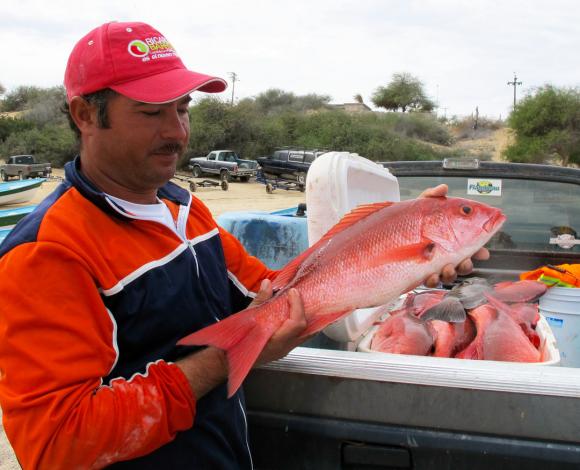Market forces are generally seen as a bad thing for environmental sustainability. The demand for fossil fuels, for example, is clearly bad for the climate. But Heather Leslie, assistant professor of environmental studies and biology, says it’s a mistake to assume market forces and sustainability must always be at loggerheads. In a recently published paper, Leslie and a group of researchers including an economist and a mathematician from Brown, show one case in which market demand could be leveraged to increase both commerce and sustainability.
The work focuses on small-scale fisheries near La Paz, Mexico. Restaurateurs around La Paz pay a premium for fish that fit nicely on a plate. Local fishermen are responding to that demand by fishing preferentially for these medium-sized fish. Leslie and her colleagues show how, with only a modicum of regulatory enhancement, market demand for “plate-sized” fish could lead to both more money for fishermen and a healthier fish stock.
Leslie discussed her research with Kevin Stacey.
How might a preference for “plate-sized” fish be beneficial for fish stocks?
Tourists’ preference for plate-sized fish functions something like a slot limit. By encouraging fishermen to catch the medium-sized fish and leave both the larger and small fish in the ocean, there’s more potential for the fish population to be sustained. The large fish are particularly important — they produce many, many more offspring than smaller reproductive adults — and by allowing them to reproduce, fishermen are essentially building the natural capital of the ocean. It’s more sustainable to draw from the interest generated by these big fish by fishing the plate-sized individuals, rather than the big fish themselves.
How is this preference currently affecting fishermen and fish stocks in La Paz?
Pacific red snapper constitute a substantial and increasing fraction of commercial fin fish landings and revenue in the region around La Paz. Based on logbook information shared with us by fishermen from three fishing cooperatives in the La Paz area, we documented that [fishing cooperatives] are paid more for plate-sized Pacific red snapper and that they preferentially catch medium-sized fish. This is a day-boat fishery, where fishermen travel offshore in small boats called pangas to harvest animals that have congregated in certain spots to breed. Fishing effort is still relatively low, compared to other areas in Mexico, which is part of the reason why we think market demand alone seems to be enabling a profitable fishery. However, our analyses suggest that if fishermen were able to improve their selectivity and catch an even higher proportion of plate-sized fish — as opposed to the smaller and larger individuals — that both profits and the fish stocks would increase. The increased fish stock would essentially function as “money in the bank,” enabling fishermen to continue to benefit from the numerous offspring produced by the largest fish and to sustain the fishery.
What could be done in enhance this market preference to benefit fishermen and fish?
Fishing cooperatives can promote more selective fishing by passing on a proportion of the price premium for plate-sized fish to their members, mandating the use of certain gear or fishing locations, and sharing knowledge of the benefits of selective harvest. Importantly, fishing cooperatives and other local managers have an important role [in determining] how many and how much fishing occurs. The benefits of the price premium for plate-sized fish — both for the fish and the fishermen — are undermined if the higher price attracts more fishermen to the fishery and increases the total harvest. While the Mexican government regulates small-scale fisheries, in La Paz, as in many other parts of the world, there is not a lot of on-the-water capacity for enforcement. Consequently, local institutions like the fishing cooperatives have a particularly important role to play in sustaining both the fish and fishing livelihoods.
How did interdisciplinary collaboration help this work?
We initiated this project through Brown’s Environmental Change Initiative, which fosters research collaborations with colleagues engaged in environmental research and practice across the campus and around the world. Sheila Walsh Reddy, the study’s lead author, arrived at Brown as one of ECI’s inaugural postdoctoral scholars in 2009. This was the start of a very productive series of interdisciplinary research projects between several Brown faculty, including Sriniketh Nagavarapu, assistant professor of economics and environmental studies; Martin Maxey, professor of applied mathematics; and myself. Our work has attracted support from the U.S. National Science Foundation’s Coupled Natural and Human Systems (CNH) program and also enriched the training of several undergraduates, including Allison Wentz, an applied mathematics concentrator whose thesis work contributed directly to the study we’re discussing today.
Is there a message in these findings that goes beyond fisheries?
Natural resource management studies and strategies typically ignore market demand or assume it has negative effects on natural resources. This approach may miss opportunities to benefit both people and nature. Our research in Mexico illustrates how integrated analysis of human-ocean systems can inform more strategic management that leverages these opportunities.
Could you talk a little about La Paz and why this area is interesting for the study of coastal communities?
La Paz has long been a vibrant area of interactions between people and the marine environment. The diversity and abundance of life both on land and in the sea have attracted human settlement for millennia. Tourism and fisheries are both important economic drivers in La Paz and these industries require healthy oceans. People travel to tropical environments like La Paz to fish and swim and watch wildlife. Understanding how to sustain marine resources and the ecosystems that support them are critical, both for human well-being and for ocean health. Our team is working in collaboration with cooperative leaders and other partners in the region to better understand how to share the knowledge we are generating about human-ocean connections and perhaps more importantly to figure out what questions we should ask next.

